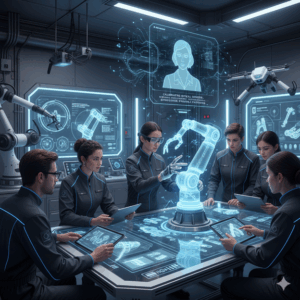Developing a Competitive, Responsive, and Skilled Workforce

Today’s conversation regarding the emerging and evolving role of AI modalities in traditional teaching and learning spaces focuses more on enhancing traditional subject instruction. However, limiting AI’s role to those content areas misses the timely conversation of AI’s potential impact on trade schools and vocational training. Integrating AI into vocational education is vital for creating a highly skilled technical workforce that is competitive and can thrive in today’s rapidly evolving global economy.
How Trade and Vocational Schools Can Benefit from AI Integration
Trade and vocational schools focus on teaching more practical, “hands-on” skills, such as automotive repair, carpentry, electrical work, HVAC systems, industrial automation, medical assisting, plumbing, and the like. These experiential and technical fields are transitioning into emerging technological changes, including smart systems that monitor data to inform diagnostics, provide real-time feedback, and facilitate predictive maintenance. To ensure vocational learners are highly skilled and competitively adept, trade education must keep pace with conventional education by integrating AI technologies into conventional hands-on learning.
Accordingly, AI in trade and vocational education has the potential to support the following:
• Simulated training & virtual environments enable learners to practice tasks before working with real equipment or with live patients.
• Concurrent diagnostics and immediate feedback so learners can correct errors in real time for more efficient learning.
• Adaptive and personalized learning paths that adjust to a learner’s current mastery level, helping learners who may be struggling to catch up or enabling advanced learners to move ahead.
• AI-augmented tools in the field, such as smart vehicle diagnostics, predictive maintenance in manufacturing, or simulated patients, so learners become familiar with what they may encounter on the actual job site.
• Efficiency in trade school operations, such as automating administrative work, tracking learner performance metrics, and helping instructors focus on mentoring and working dynamically alongside learners in real time rather than purely delivering static content.
Creating a More Skilled, Competitive Workforce through AI-Integration
Integrating AI into trade and vocational education has several advantages for educators and learners. AI-integrated trade learning helps ensure that learners are not only highly employable but also possess the adaptability and malleability to succeed in a rapidly evolving job market in the AI era.
• Application: Trade and vocational learners are trained not just in conventional techniques but also in current and future tools and technologies being used in industry. For example, learners trained in AI-facilitated automotive repair and experienced in diagnosing issues via AI or smart sensors, or a nursing assistant trained using patient simulations, will be in higher demand than learners with only traditional learning experiences.
• Efficiency in Mastery: AI-facilitated learning enables faster feedback during simulations of more complex tasks. Through adaptive learning, learners can achieve competency by making fewer mistakes and gaining more confidence. Training quality is improved, and results are achieved in a shorter timeframe.
• Lifelong, Adaptable Learners: As technology continues to evolve, learners must adapt to changes, and those who are already comfortable with AI tools can adapt more easily as their field evolves.
• Economic Competitiveness: Having a workforce that embraces AI in trade fields means business and industry can keep pace with global innovation. Businesses require tradespeople who can operate and maintain AI‐powered systems. If the workforce lacks these more nuanced technical skills, businesses and industries will lag behind and become less competitive.
• Focusing on Skill Gaps: There are many businesses and industries that are currently experiencing significant shortages of highly qualified workers. AI-enhanced training can help produce well-trained graduates more efficiently, especially in fields where traditional, resource-intensive methods are not cost effective or efficient.
How Institutions Can Address Existing and Emerging Challenges
To make AI in trade schools effective and efficient, institutions should consider:
• Updating Infrastructure and Equipment: The initial investment in transition from traditional hands-on training to AI-enabled training can be quite costly. Not all trade schools have the financial means to invest in VR/AR labs, simulation tools, and other related equipment.
• Modernizing Teacher/Instructor Training: Instructors must be highly accomplished and proficient not only in how to use AI tools, but how to integrate them in their teaching using pedagogic best practices that balance practical application with feedback and learner progress.
• Adaptable Curriculum Design: Institutions and educators must ensure that AI is appropriately aligned with employer needs and not just what is novel or possible when training is AI-facilitated. Ongoing collaboration and responsive partnerships with business and industry are crucial.
• Assessment and Accreditation: Trade certifications must meet very strict industry standards. Institutions must ensure that AI tools align with these standards and are validated, so that competencies assessed via AI simulations are trusted and verified in the practical workplace.
 AI tools are not just a novel technology luxury or a tool only used for teaching academic subjects. Trade and vocational education have much to gain from AI-mediated learning. When properly implemented, AI in trade and vocational schools helps create a workforce that is highly adaptive, skilled, and ready for the evolving technical demands of the 21st century worker. There should be increased advocacy for trade schools to be part of AI education discussions, funding opportunities, policy frameworks, and professional development to ensure that all learners, not only those in traditional classrooms, benefit from these advances.
AI tools are not just a novel technology luxury or a tool only used for teaching academic subjects. Trade and vocational education have much to gain from AI-mediated learning. When properly implemented, AI in trade and vocational schools helps create a workforce that is highly adaptive, skilled, and ready for the evolving technical demands of the 21st century worker. There should be increased advocacy for trade schools to be part of AI education discussions, funding opportunities, policy frameworks, and professional development to ensure that all learners, not only those in traditional classrooms, benefit from these advances.

Rebecca Blankenship
Rebecca J. Blankenship is an award-winning educator and researcher with over 25 years of teaching experience. Her current research examines the ecologies of meanings as a systems-based, hermeneutic approach to ethics in AI and gen-AI teaching and learning modalities. She is currently an Associate Professor in the College of Education at Florida Agricultural and Mechanical University.
